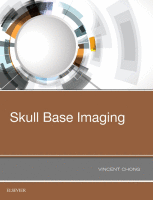Physical Address
304 North Cardinal St.
Dorchester Center, MA 02124

In this chapter, we discuss the embolization of the most common hypervascular tumors and vascular lesions occurring at the skull base (i.e., the juvenile angiofibromas [JAFs], paragangliomas [PGLs], dural arteriovenous fistula [DAVF], and traumatic carotid-cavernous fistula [CCF]). Other rare diseases…

Introduction Most tumors affecting the skull base result from hematogenous spread of primary malignancies outside the skull base (hematogenous bone metastases) or from direct invasion or perineural spread of neoplasms arising from neighboring structures of the suprahyoid neck. As the…

Introduction The skull base is a bony-cartilaginous structure, oriented in the axial plane, providing a barrier between the intracranial compartment and the extracranial head and neck. It is pierced by several neurovascular foramina, which provide a crossroad for disease to…

The craniovertebral junction (CVJ) supports the head and enables its flexion and rotation in three dimensions. It has a complex anatomic structure consisting of the vertebral column, paraspinal soft tissue, ligaments, and joints between the clivus, occipital bone, foramen magnum,…

The jugular foramen is a complex bony canal containing neurovascular structures deep in the skull base. It is inaccessible to direct clinical examination and difficult to access surgically because of the surrounding critical structures. Radiology plays a central role in…

Introduction The cerebellopontine angle (CPA) cistern is a subarachnoid space within the posterior cranial fossa. About 6%–10% of all intracranial masses are found in this location. Vestibular schwannomas (VSs) are the most commonly encountered lesion in the CPA, followed by…

Introduction The petrous apex is the most medial portion of the temporal bone. Its deep location precludes direct clinical examination and safe percutaneous biopsy. In addition, many of the petrous apex lesions are asymptomatic or present with nonspecific symptoms such…

Introduction Interpretation of CT or MR imaging examinations performed on patients with a history of middle ear (ME), mastoid, or neurotologic surgery can be challenging. This is greatly simplified by knowing the surgical procedures used and the expected postoperative appearance.…

Anatomy The facial nerve comprises motor, sensory, and parasympathetic fibers. The dominant motor component comprises 70% of the total axons. The sensory component makes up much of the remaining portion of the nerve and includes the nervus intermedius (nerve of…

Disclosure Disclosure of any relationship with a commercial company that has a direct financial interest in subject matter or materials discussed in article or with a company making a competing product. Introduction In the imaging evaluation of hearing loss, the…